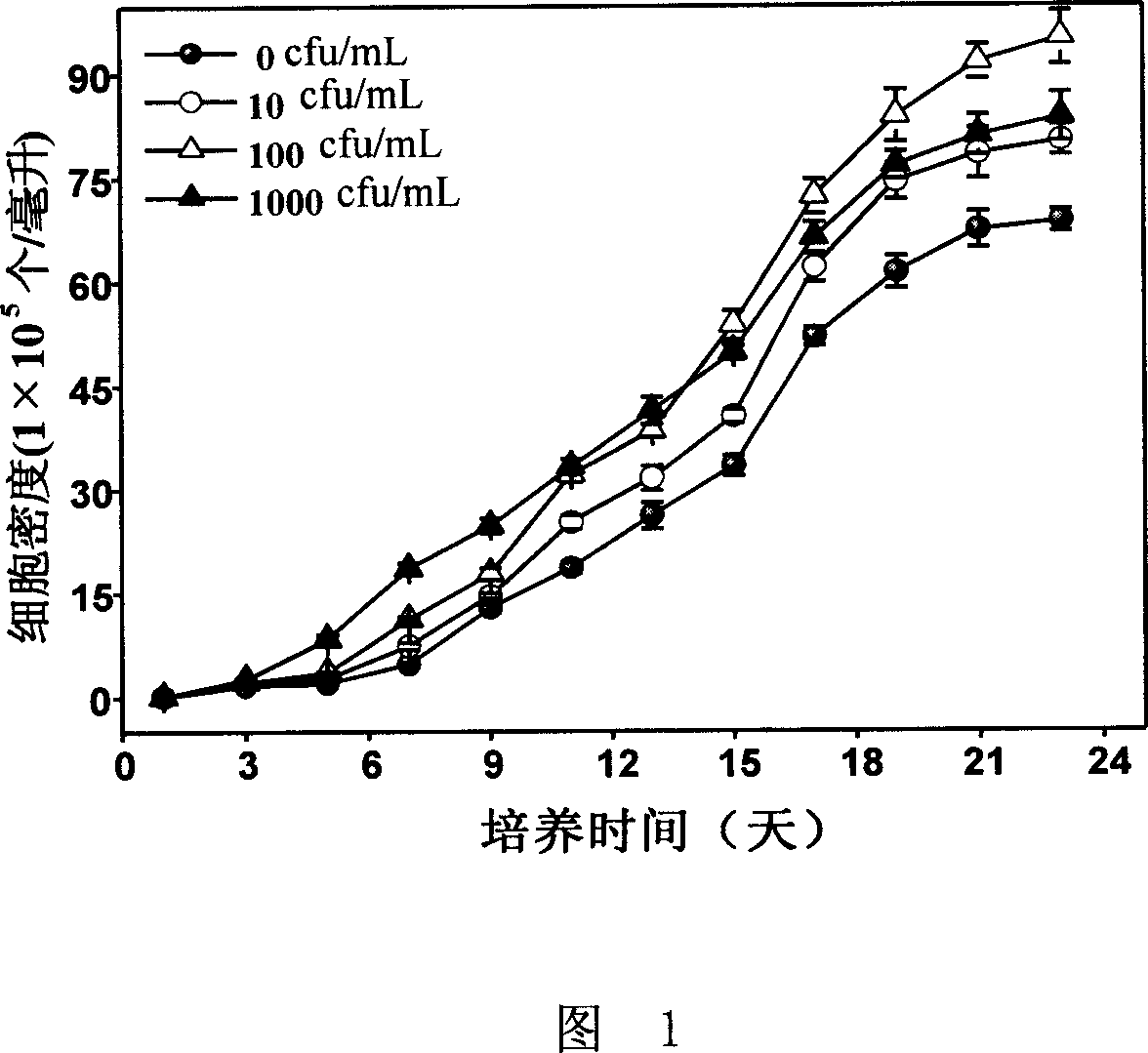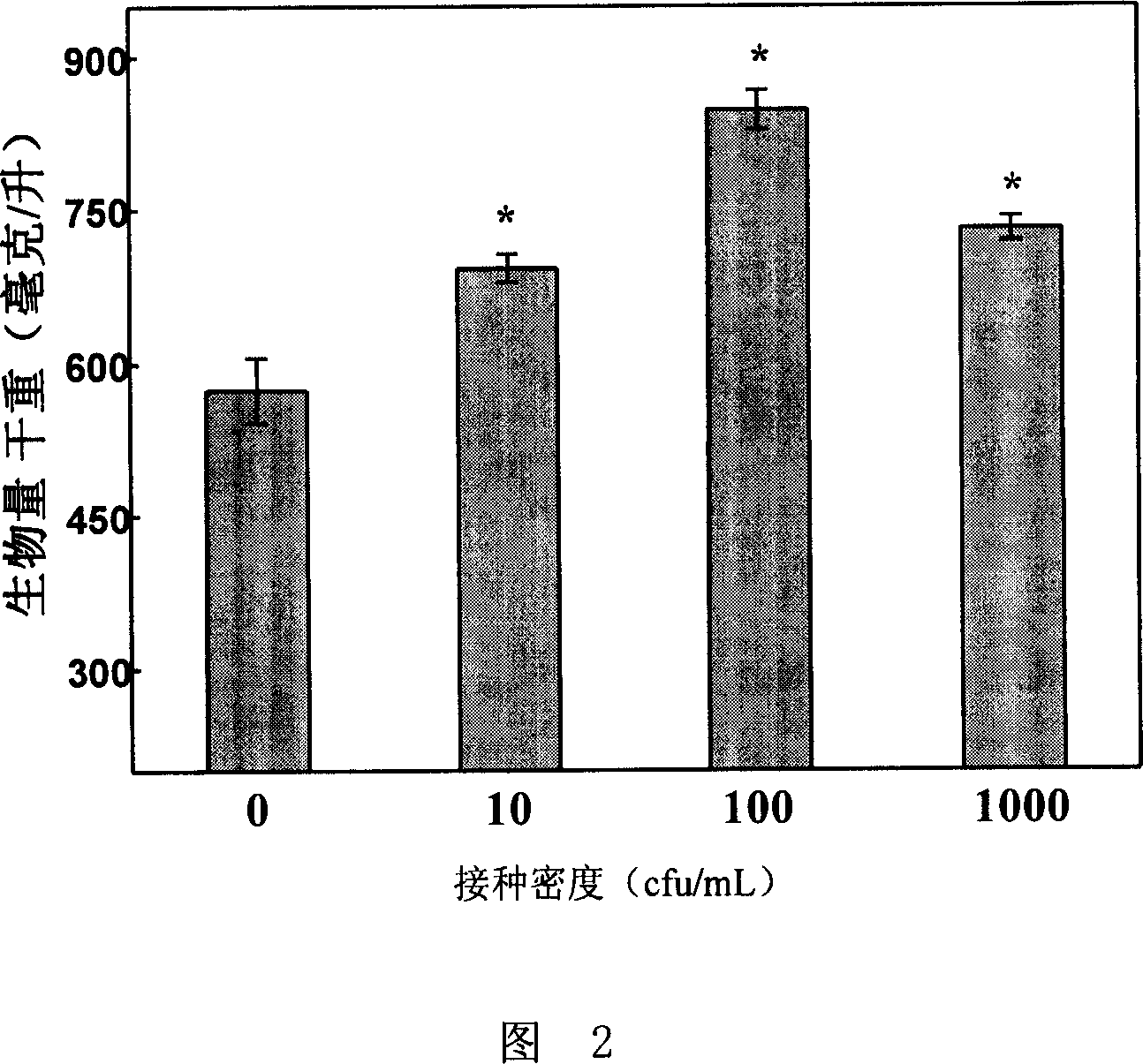Culture method of dunalilla salina
A technology of salt algae and culture medium, which is applied in the field of cultivation of salina salina, which can solve the problems of insignificant increase in the biomass and metabolites of salina salina, high viscosity of the culture solution, and unfavorable algae absorption, etc., and achieves easy large-scale cultivation and simple operation , the effect of promoting the growth and division of algae cells
- Summary
- Abstract
- Description
- Claims
- Application Information
AI Technical Summary
Problems solved by technology
Method used
Image
Examples
Embodiment 1
[0019] Embodiment 1, the cultivation of salina and the influence of inoculated bacillus of different densities on the growth rate of salina 5The density of cfu / mL was inoculated in Modified Johnson's medium (pH 7.5), and at the same time, according to the inoculation amount of 0 (control), 10, 100, and 1000 cfu / mL, Bacillus pumilus was inoculated into the medium, and at 24 ℃, light intensity 150μmoles·m -2 ·s -1 , under the condition of light time 10h / day, culture Salina salina to detect the influence of different densities of Bacillus on the growth rate of Salina salina. When culturing to the end of logarithmic growth, count with a hemocytometer under a microscope the next day, using the formula K=(N-N 0 ) / T(N is the number of algal cells per unit volume after T time cultivation, N 0 The initial unit volume of algae cells is cultivated for T time, and T is the culture time (day)) to calculate the daily average growth rate (K) of salina. The statistical results of the cell...
Embodiment 2
[0020] The cultivation of embodiment 2, salina and the influence of the bacillus of inoculating different densities on the biomass of salina
[0021] Press Salina to 1×10 5 The density of cfu / mL was inoculated in Modified Johnson's medium (pH 7.5), and at the same time, Bacillus subtilis (Bacillus subtilis) was inoculated into the medium according to the inoculation amount of 0 (control), 10, 100, and 1000 cfu / mL respectively. ℃, light intensity 100μmoles·m -2 ·s -1 , light time 14h / day, under the conditions of 100rpm, shake culture of Salina salina, in order to detect the impact of different densities of Bacillus on the biomass of Salina salina. When the culture reaches the end of logarithmic growth, take 400mL of the algae solution inoculated with different densities of Bacillus, centrifuge at 4800rpm for 10min, discard the supernatant, desalinate the algae, freeze, vacuum dry, and weigh to obtain the biomass of Salina. The statistical results of biomass are shown in Figu...
Embodiment 3
[0022] Example 3, the cultivation of salina and the impact of inserting different densities of bacillus on the accumulation of salina β-carotene
[0023] Press Salina to 1×10 5 The density of cfu / mL was inoculated in Modified Johnson's medium (pH 7.5), and at the same time, Bacillus coagulans (Bacillus Coagulans) was inoculated into the medium according to the inoculation amount of 0 (control), 10, 100, and 1000 cfu / mL respectively, at 25 ℃, light intensity 130μmoles·m -2 ·s -1 , light time 12h / day, 130rpm under the conditions of shaking culture of Salina salina, in order to detect the impact of inoculating different densities of Bacillus on the accumulation of β-carotene in Salina salina. During the cultivation process, the β-carotene accumulation of Salina salina was measured every 3 days. The method is as follows: First, according to the literature (Liu Jianguo, Wu Chaoyuan. Review of Salina salina and β-carotene research [J]. Ocean and Limnology, 1995, 26 (3): The metho...
PUM
 Login to View More
Login to View More Abstract
Description
Claims
Application Information
 Login to View More
Login to View More - R&D
- Intellectual Property
- Life Sciences
- Materials
- Tech Scout
- Unparalleled Data Quality
- Higher Quality Content
- 60% Fewer Hallucinations
Browse by: Latest US Patents, China's latest patents, Technical Efficacy Thesaurus, Application Domain, Technology Topic, Popular Technical Reports.
© 2025 PatSnap. All rights reserved.Legal|Privacy policy|Modern Slavery Act Transparency Statement|Sitemap|About US| Contact US: help@patsnap.com



